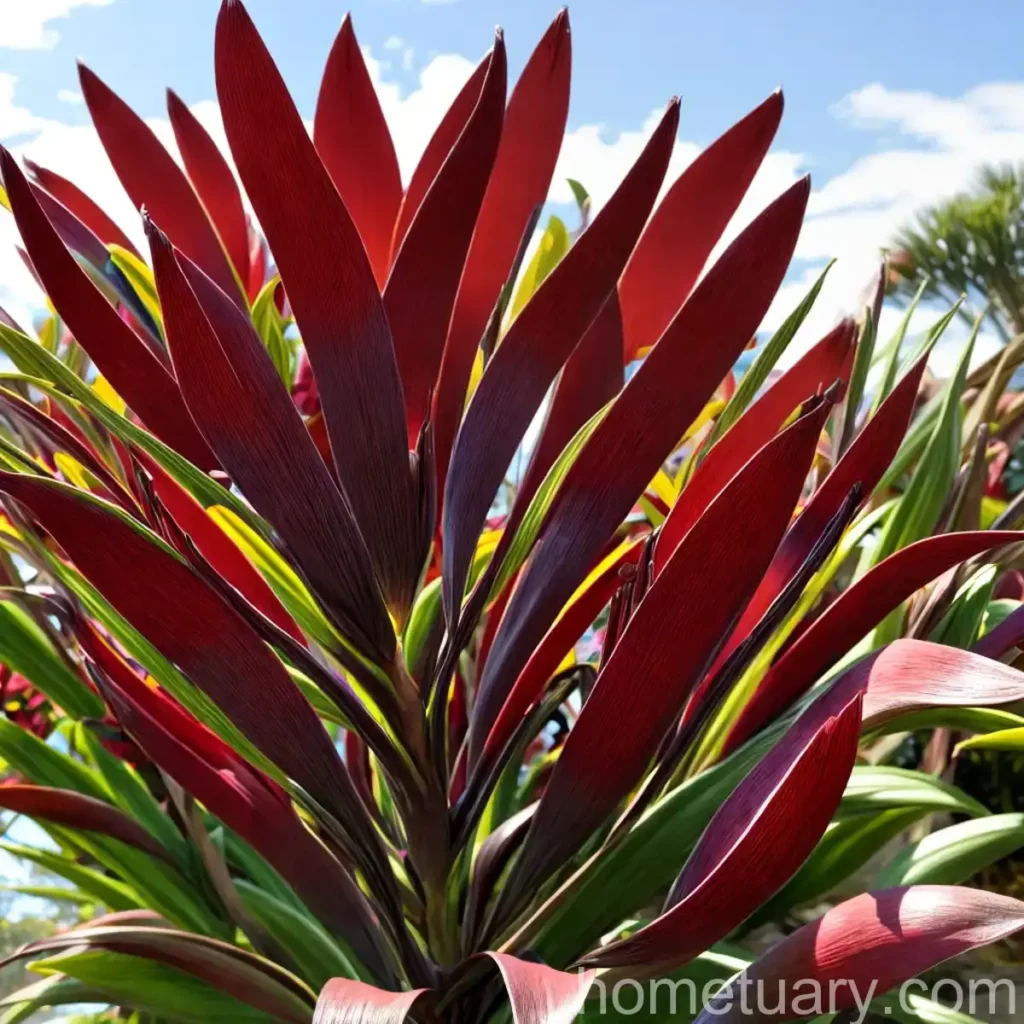New Zealand Flax (Phormium ‘Jester’)
New Zealand flax, scientifically known as Phormium ‘Jester’, is a striking and versatile plant that has gained popularity in gardens and landscapes worldwide. This ornamental plant is valued for its colorful foliage, architectural form, and resilience in various growing conditions. In this comprehensive guide, we will explore the key aspects of caring for and cultivating New Zealand flax. From its cultural significance to its uses in landscaping and tips for maintenance, you will discover a wealth of knowledge about this remarkable plant.
What is Plant: New Zealand Flax (Phormium ‘Jester’)?
New Zealand flax, or Phormium ‘Jester’, is a perennial plant native to New Zealand. It belongs to the Phormium genus within the family Asphodelaceae. The plant is characterized by its sword-shaped leaves that come in a stunning array of colors, including variegated patterns of green, red, pink, and yellow. Phormium ‘Jester’ is a hybrid variety valued for its vibrant and eye-catching foliage, making it a popular choice for adding visual interest to gardens and landscapes.
Key Takeaways – New Zealand Flax (Phormium ‘Jester’)
- Common Name: New Zealand Flax
- Scientific Name: Phormium ‘Jester’
- Family: Asphodelaceae
- Origin: New Zealand
- Foliage: Sword-shaped leaves in various colors and variegated patterns
- Characteristics: Architectural form, drought tolerance, and vibrant foliage
Now, let’s delve into the essential aspects of caring for New Zealand flax, including its cultural significance, uses, and detailed cultivation guidelines.
Culture
Understanding the cultural context of New Zealand flax is essential for appreciating its significance and symbolism. In traditional Maori culture, flax holds immense importance as a valuable and versatile resource. The leaves of the flax plant were used for weaving baskets, mats, clothing, and even building shelters. Additionally, the plant has spiritual significance for the Maori people, featuring prominently in their mythology and rituals.
Uses
New Zealand flax has transcended its cultural origins and found diverse uses in modern landscapes and gardens. Its striking foliage and structural form make it a captivating addition to ornamental gardens, where it can be used as a focal point, border plant, or mass planting for dramatic visual impact. Moreover, its versatility extends to its practical applications, as the long, fibrous leaves can be utilized for crafts, such as weaving and basketry. The plant’s resilience also makes it suitable for erosion control in landscaping projects, particularly in coastal environments.
Water
Understanding the water requirements of New Zealand flax is crucial for ensuring its optimal growth and health. While New Zealand flax is relatively drought-tolerant once established, it thrives best with regular watering during its active growing season. Adequate moisture is particularly important for newly planted specimens and during periods of prolonged dryness. When watering New Zealand flax, it is essential to strike a balance, providing enough moisture without causing waterlogging, which can lead to root rot.
Sunlight
New Zealand flax exhibits a preference for full sun to partial shade, making it adaptable to a range of light conditions. In regions with intense sunlight and high temperatures, some afternoon shade can benefit the plant, preventing excessive heat stress and maintaining the vibrancy of its foliage. When grown in partial shade, the variegated varieties of New Zealand flax may display more vivid coloration due to reduced sun exposure. Understanding the light requirements of the specific Phormium ‘Jester’ cultivar in your care is essential for optimizing its visual appeal and overall health.
Fertilizer
Appropriate fertilization can enhance the growth and visual allure of New Zealand flax. During the plant’s active growing season, applying a balanced, slow-release fertilizer can provide the necessary nutrients for robust foliage development and overall vigor. A fertilizer with a higher nitrogen content can support lush foliage growth while ensuring that other essential nutrients, such as potassium and phosphorus, are also present in adequate quantities. It is important to follow the manufacturer’s recommendations and avoid over-fertilizing, as excessive nitrogen levels can lead to overly lush foliage that is more susceptible to damage.
Soil
New Zealand flax thrives in well-draining soil with a slightly acidic to neutral pH range. The soil should be rich in organic matter to support healthy growth and moisture retention without becoming waterlogged. If your garden soil is heavy and prone to waterlogging, amending it with organic matter, such as compost, can improve drainage and create an optimal growing environment for New Zealand flax. When planting New Zealand flax in containers, choosing a high-quality potting mix designed for ornamental plants can provide the necessary aeration and drainage required for container cultivation.
Pruning
Pruning is a crucial aspect of New Zealand flax maintenance, contributing to the plant’s overall health and aesthetic appeal. Regular removal of old or damaged leaves is recommended to maintain the plant’s tidy appearance and encourage the growth of new foliage. When performing pruning, it is advisable to use clean, sharp tools to minimize the risk of injury to the plant and ensure precision in removing unwanted growth. Additionally, for variegated varieties such as Phormium ‘Jester’, timely removal of any solid-colored shoots can help preserve the distinct patterns and coloration of the foliage.
Propagation
Propagating New Zealand flax allows for the expansion of your plant collection and the preservation of desirable traits in specific cultivars, such as Phormium ‘Jester’. The plant can be propagated through various methods, including division and seed propagation.
Division
Division involves separating the offsets or “pups” that develop around the base of mature New Zealand flax plants. This method is best carried out in spring when the plant is actively growing. Carefully digging up the plant and dividing the offsets with a sharp, sterile tool allows you to create new plants with established root systems, ensuring their successful establishment.
Seed Propagation
Growing New Zealand flax from seeds offers the opportunity to introduce new varieties and observe the unique traits exhibited by the resulting seedlings. To propagate Phormium ‘Jester’ from seeds, start by collecting mature seeds from the plant. Sow the seeds in a well-draining, sterile seed-starting mix and provide the appropriate warmth and moisture for germination. As the seedlings develop, transplant them into individual containers or prepared garden beds, allowing them to flourish and develop into mature plants over time.
Container Popularity
The versatility and eye-catching appeal of New Zealand flax, particularly the captivating Phormium ‘Jester’ variety, have contributed to its popularity as a container plant. Cultivating New Zealand flax in containers offers numerous advantages, allowing for greater control over growing conditions, mobility for placement in various settings, and the opportunity to showcase the plant’s ornamental qualities in smaller spaces.
Container
When selecting a container for New Zealand flax, it is essential to choose a size that accommodates the plant’s mature size and allows for adequate root development. Additionally, the container should have drainage holes to prevent waterlogging, promoting healthy root growth and overall plant vigor. High-quality, well-draining potting mix provides the necessary support and moisture retention for New Zealand flax grown in containers, ensuring optimal growing conditions and robust development.
Common Diseases
Like all plants, New Zealand flax, including the Phormium ‘Jester’ variety, is susceptible to certain diseases that can affect its growth and vitality. Understanding and recognizing common diseases is essential for timely intervention and effective management to safeguard the plant’s health.
Disease Diagnosis
Several diseases can impact New Zealand flax, including fungal infections and bacterial diseases. Common signs of disease in New Zealand flax may include discoloration, spotting, wilting, and overall decline in plant vigor. Fungal diseases, such as leaf spot and root rot, can be identified by characteristic lesions on the foliage, stems, or roots. Bacterial infections may manifest as oozing cankers, yellowing, and stunted growth. Prompt diagnosis through visual inspection and, if necessary, laboratory analysis can aid in implementing targeted treatment measures to mitigate the spread and impact of diseases.
Common Pests
New Zealand flax, including the vibrant Phormium ‘Jester’ cultivar, may face challenges from various pests that can compromise its growth and ornamental appeal. Being aware of common pests and their characteristic damage can facilitate proactive pest management and minimize the risk of infestations.
Botanist’s Tips
- Soil Drainage: Ensuring proper soil drainage is crucial for preventing waterlogging, which can lead to root rot and other adverse effects on New Zealand flax.
- Pruning Practices: Regular pruning of dead or damaged foliage is essential for maintaining the plant’s aesthetics and preventing the accumulation of decaying material, which can attract pests and pathogens.
- Fertilization Frequency: While New Zealand flax benefits from fertilization during its active growth period, it is important to avoid excessive or frequent applications, as this can lead to imbalances and potential leaf damage.
Fun Facts
- New Zealand flax has been traditionally significant for the indigenous Maori people of New Zealand, with its fibers used in weaving, and the plant featuring prominently in their cultural practices and beliefs.
- The foliage of Phormium ‘Jester’ exhibits a captivating range of colors and patterns, making it a standout ornamental plant in garden settings.
- New Zealand flax is known for its adaptability to diverse climates, showcasing its resilience in both coastal and inland environments.
Links to External Resources
To further explore the world of New Zealand flax and enrich your understanding of its cultivation, uses, and significance, the following external resources provide valuable insights and information:
- Royal New Zealand Institute of Horticulture: Phormium Cultivars
- New Zealand Plant Conservation Network: Phormium
- The Royal Horticultural Society: Growing Guide for Phormium
- Landscaping New Zealand Flax by University of California Agriculture and Natural Resources
- New Zealand Flax: A Cultural Icon – Te Ara Encyclopedia of New Zealand
- Phormium: The Versatile, Low-Maintenance Landscape Plant by University of Florida IFAS Extension
Incorporating insights from these resources can broaden your knowledge and provide valuable guidance for successfully cultivating and appreciating New Zealand flax, including the captivating Phormium ‘Jester’ variety.
With its rich cultural significance, striking visual appeal, and versatility in landscaping, New Zealand flax, exemplified by the distinctive Phormium ‘Jester’, continues to captivate plant enthusiasts and gardeners. By embracing the key principles of care and cultivation highlighted in this guide, you can embark on a rewarding journey of nurturing and enjoying the exceptional beauty and resilience of this remarkable plant. Whether poised as a statement plant in garden designs or integrated into sustainable landscapes, New Zealand flax stands as a testament to nature’s artistry and the enduring connection between plants and people.















